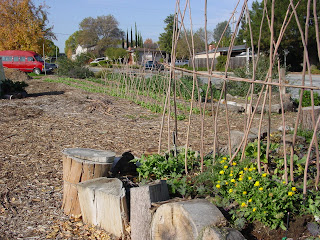Wishing you peace and joy in your Hearts at this winding down time of the year. In order to create health and healing by focusing on the positive (And do we truly know what is 'Positive"?) we have posted a sheet on the community notice board at the garden. It reads: 2011 What are you grateful for? It is our hope that passers by will be able to write in something that they are grateful for. Around the end of the month we plan to set up a sheet that invites hopes, wishes and prayers for the New Year. Right now we invite you to tell everyone what you are grateful for. You might also post that comment in the
comment box below.
The Green house suffered a couple of plastic windows being ripped off in the strong winds last week. Happily our Garden Friend Kent was able to reinstall them. In the green house we have 2 Tomato plants in ground. Also starts of Lettuce, Peas and Fava beans. The Lettuce might need to stay in the warmth of the green house as protection from the frosts to come. The Fava beans and Snap Peas are for replacement plants in the rows outside ... or to give away.
We have harvested a few Snap Peas from the early September planting. The bulk of the crop will become available later in the winter and into spring.
We have also just harvested Potatoes, Sunchokes, Lettuce, Carrots, Swiss Chard, Collards, 3 different types of Kale, Turnips and a few late Squash.
There are some Sun Gold Tomatoes, and you might be lucky, but personally I think the flavor of December Tomatoes is often a disappointment (there, another opportunity to live in gratitude without rigid expectations, and we do have a lot of fine fare to be harvested even now so close to the Solstice).
That is one myth that we are dissolving. The idea that there is nothing to be gained from a garden in winter. For the second winter season we have demonstrated there is a lot of healthy fresh food to be harvested in this region.
Along with that is the other myth that there is nothing to be done in the garden through the winter months. Most recently we have been:
Harvesting.
Building and turning the compost.
Weeding and removing old plants such as Squash, Corn, Beans, Sesame and very old kale.
Staking Peas and Beans.
Planting in the green house.
Building the Edible Weeds bed.
Wattle making.
There are still some Sunchokes to be harvested.
So on Saturday don't go to the Mall ...
Come visit us in the
Center Avenue Community Garden
Merry Christmas,
David
comment box below.
The Green house suffered a couple of plastic windows being ripped off in the strong winds last week. Happily our Garden Friend Kent was able to reinstall them. In the green house we have 2 Tomato plants in ground. Also starts of Lettuce, Peas and Fava beans. The Lettuce might need to stay in the warmth of the green house as protection from the frosts to come. The Fava beans and Snap Peas are for replacement plants in the rows outside ... or to give away.
We have harvested a few Snap Peas from the early September planting. The bulk of the crop will become available later in the winter and into spring.
 |
| White Trunips |
There are some Sun Gold Tomatoes, and you might be lucky, but personally I think the flavor of December Tomatoes is often a disappointment (there, another opportunity to live in gratitude without rigid expectations, and we do have a lot of fine fare to be harvested even now so close to the Solstice).
That is one myth that we are dissolving. The idea that there is nothing to be gained from a garden in winter. For the second winter season we have demonstrated there is a lot of healthy fresh food to be harvested in this region.
Along with that is the other myth that there is nothing to be done in the garden through the winter months. Most recently we have been:
Harvesting.
Building and turning the compost.
Weeding and removing old plants such as Squash, Corn, Beans, Sesame and very old kale.
Staking Peas and Beans.
Planting in the green house.
Building the Edible Weeds bed.
Wattle making.
There are still some Sunchokes to be harvested.
So on Saturday don't go to the Mall ...
Come visit us in the
Center Avenue Community Garden
Merry Christmas,
David








